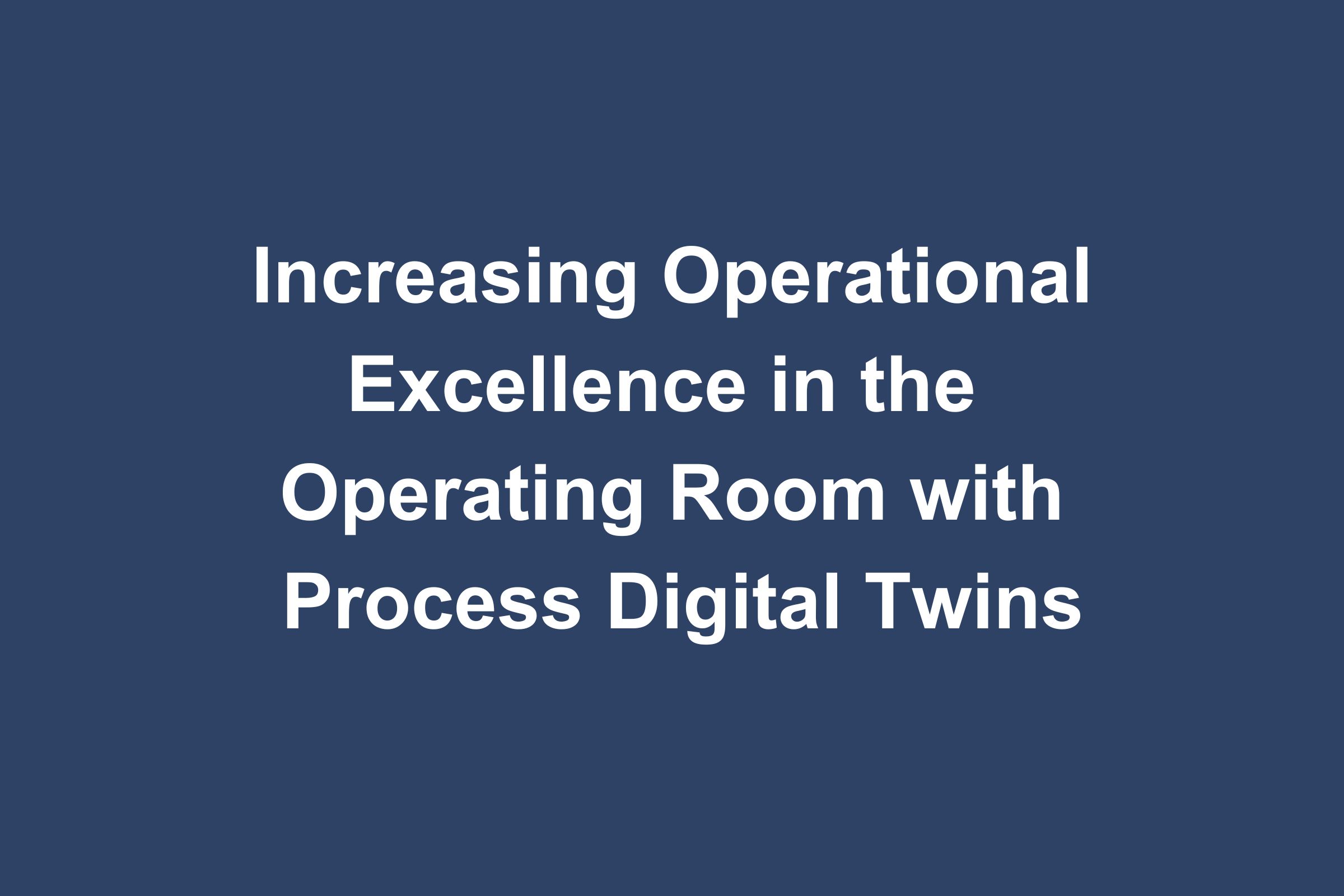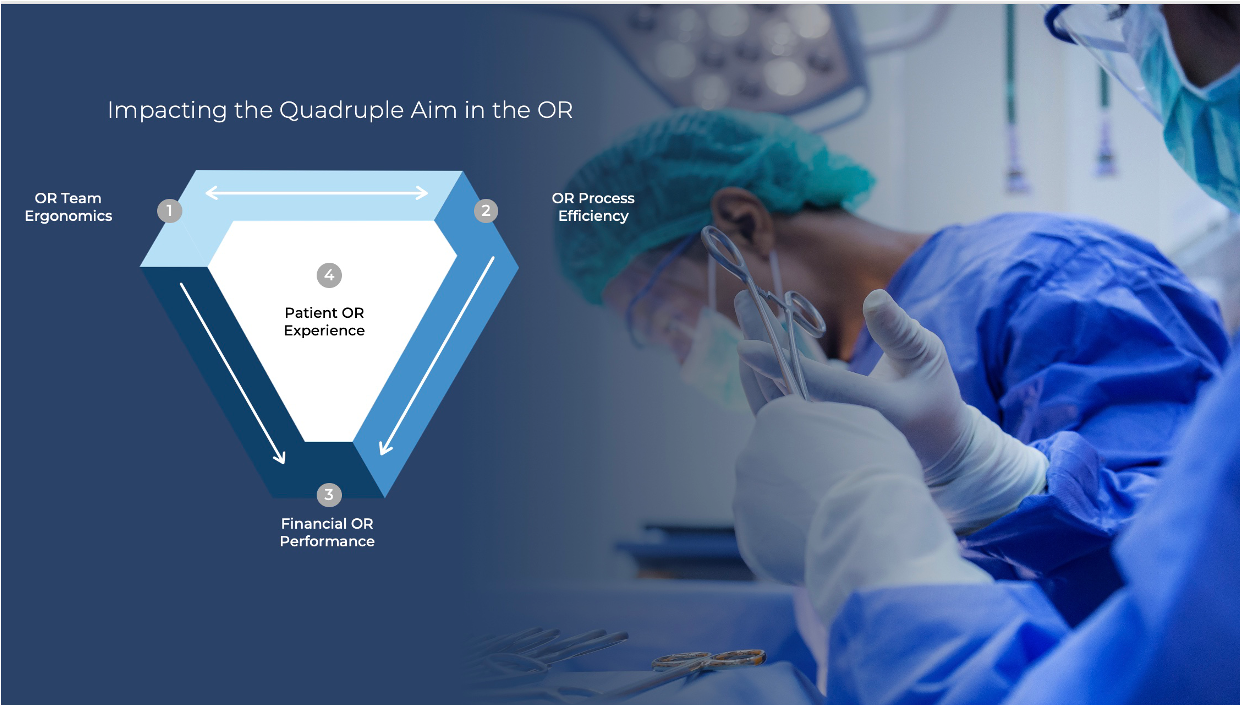Dr. Olyslaegers, Belgium: Teamwork improves operational excellence
What added value is there in creating dedicated teams around different surgical specialties, and how does such a setup improve operating room efficiency and OR throughput?
Dr. Christophe Olyslaegers, Orthopedic Surgeon at St. Augustinus, GasthuisZusters Antwerpen (GZA), Belgium, shares his experiences for creating the best environment for nursing teams, the power of team-led initiatives, and how standardization contributes to better overall team well-being and collaboration in the OR.
Lastly, we discuss the critical role of data in providing insights that ultimately reveal improvement opportunities, including a few examples of how adjustments in the OR process can save a lot of time and improve workflows.
Is there added value in creating dedicated teams around different surgical specialties?
How do you create and motivate such teams to foster a culture of improvement?
Recently, we spoke to Dr. Christophe Olyslaegers, Orthopedic Surgeon at GasthuisZusters Antwerpen (GZA), about his experiences setting up surgical teams and creating mutual accountability as the steppingstone for operating room efficiency.
Before Dr. Olyslaegers started his career in Antwerp, he completed a fellowship at the Royal Bournemouth Hospital (RBH) in the UK. At RBH, he experienced first-hand what dedicated surgical teams can do and how such a setup can improve the OR throughput.
So, when Dr. Olyslaegers returned to Antwerp, he was determined to do the same to create the best conditions for OR efficiency.
A dedicated team model: a steppingstone to OR efficiency
Today, Dr. Olyslaegers is working with a team of 12 OR nurses in the orthopedic department, 6 of them dedicated to doing hip or knee surgeries.
“They are a group of happy, humorous, and self-motivated nurses. They are fantastic to work with. They know almost every trick in the book, and if the need arises, we have each other’s backs,” says Dr. Olyslaegers enthusiastically when asked about the team he’s working with at GZA.
“That’s how good teams work, right?” says Dr. Olyslaegers.
He continues, “You might have a brilliant mind on the team, but if he or she isn’t well-integrated, no one wins. The potential for tension may impact the surgery and the overall experience in the operating room negatively. Avoiding that tension is crucial for everyone to do their job well. It’s a team effort.”
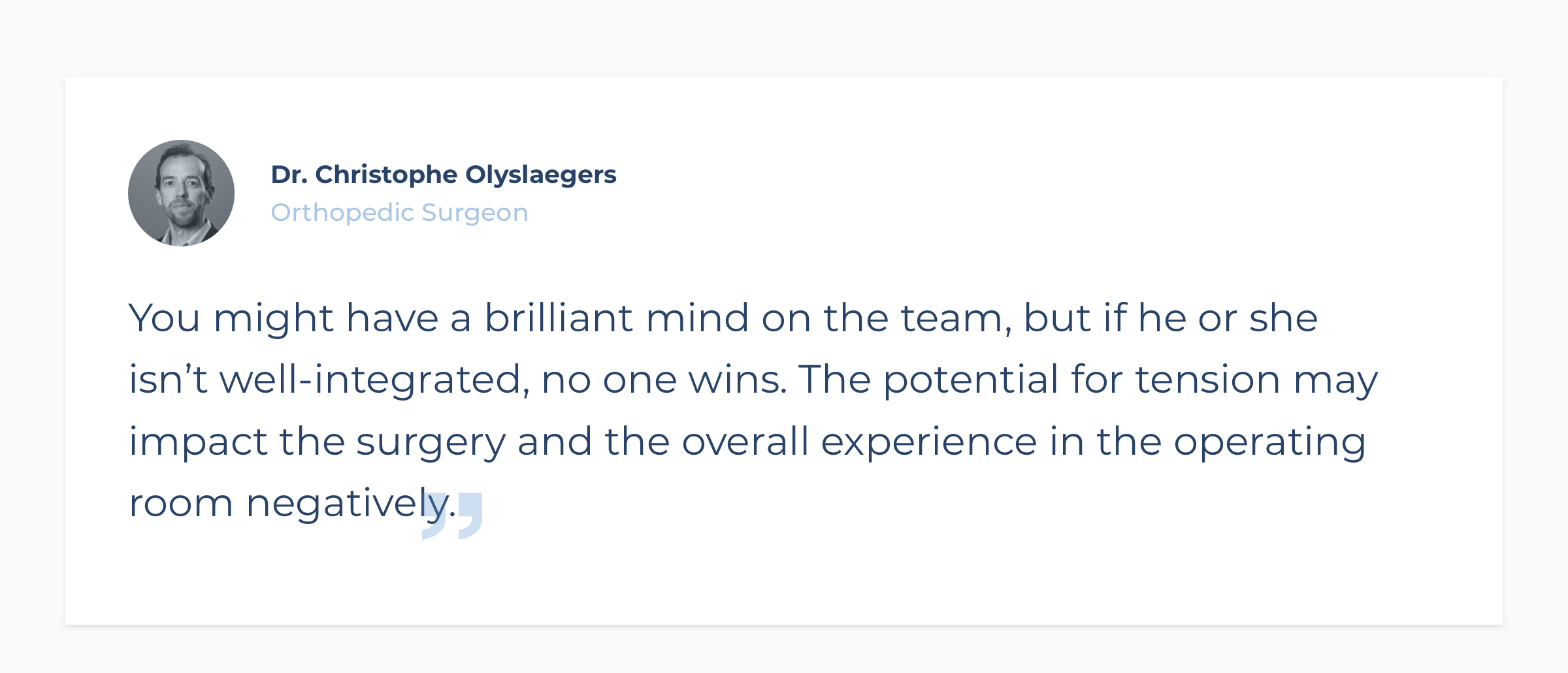
Everyone’s work is appreciated
Working with dedicated hip and knee teams has the advantage of not only getting the job done but also in improving morale.
“All of the nurses know my habits, my rituals, and how much time I usually need for a case. With this knowledge and drive, they help clear the path for me, like proactively bringing the right implants into the OR instead of waiting for me to ask for them.”
Dr. Olyslaegers adds, “Their level of expertise goes far beyond unpacking trays. In the OR, there is a genuine appreciation for the work they do, which translates into a real satisfaction and joy on their end.”
Expressing appreciation within the surgical team is rooted in a strong internal culture of camaraderie.
To this, Dr. Olyslaegers elaborates: “Because we have nurses that are dedicated to specific surgeons or surgeries, we create small families within the bigger hospital family. It’s really not rocket science, rather a matter of creating a sense of belonging for everyone.”
Do you want to learn more about the basics of OR efficiency? Check out The Why, What, and How of Operating Room Efficiency.
Team-led initiatives pave the way forward
In the orthopedic department at GZA, it isn’t only management or surgeon-led initiatives paving the way forward; it’s team-led initiatives. Everyone is interested in trying new technologies, improving processes and ways of working.
“Several orthopedic nurses ask me what is next for our OR, and it’s incredible to see the drive that’s sparking these questions. It isn’t just one thing but a combination of many: wanting to be intellectually challenged, making an impact, being proud of their jobs, and striving to be a little better with every case,” says Dr. Olyslaegers.
“It’s also about making a difference for the patient and creating the best OR environment that will provide better quality of care. This is our opportunity to make a positive impact on someone’s life.”
In Olyslaegers’ group, change initiatives are often brought to the table by the OR nursing team and gradually tested to determine what works and what doesn’t. Still, Dr. Olyslaegers believes management must take a role in driving change, too.
“Change drivers should partially come from management, but as a surgical team, you also have a responsibility to think about cost reductions, efficiency improvements, and what upgrades are possible in your practice. We should be ahead of improvement opportunities like these and engage in discussion with management.”
Data provides insights, and insights provide improvement opportunities
In conjunction with team-led initiatives, Dr. Olyslaegers and his team are consulting with external parties to discover improvement opportunities, too. “Along with our internal initiatives, DEO has been critical in providing improvement ideas.”
Over the past few years, the DEO engineering team has had the wonderful opportunity to conduct measurements in Olyslaegers’ OR.
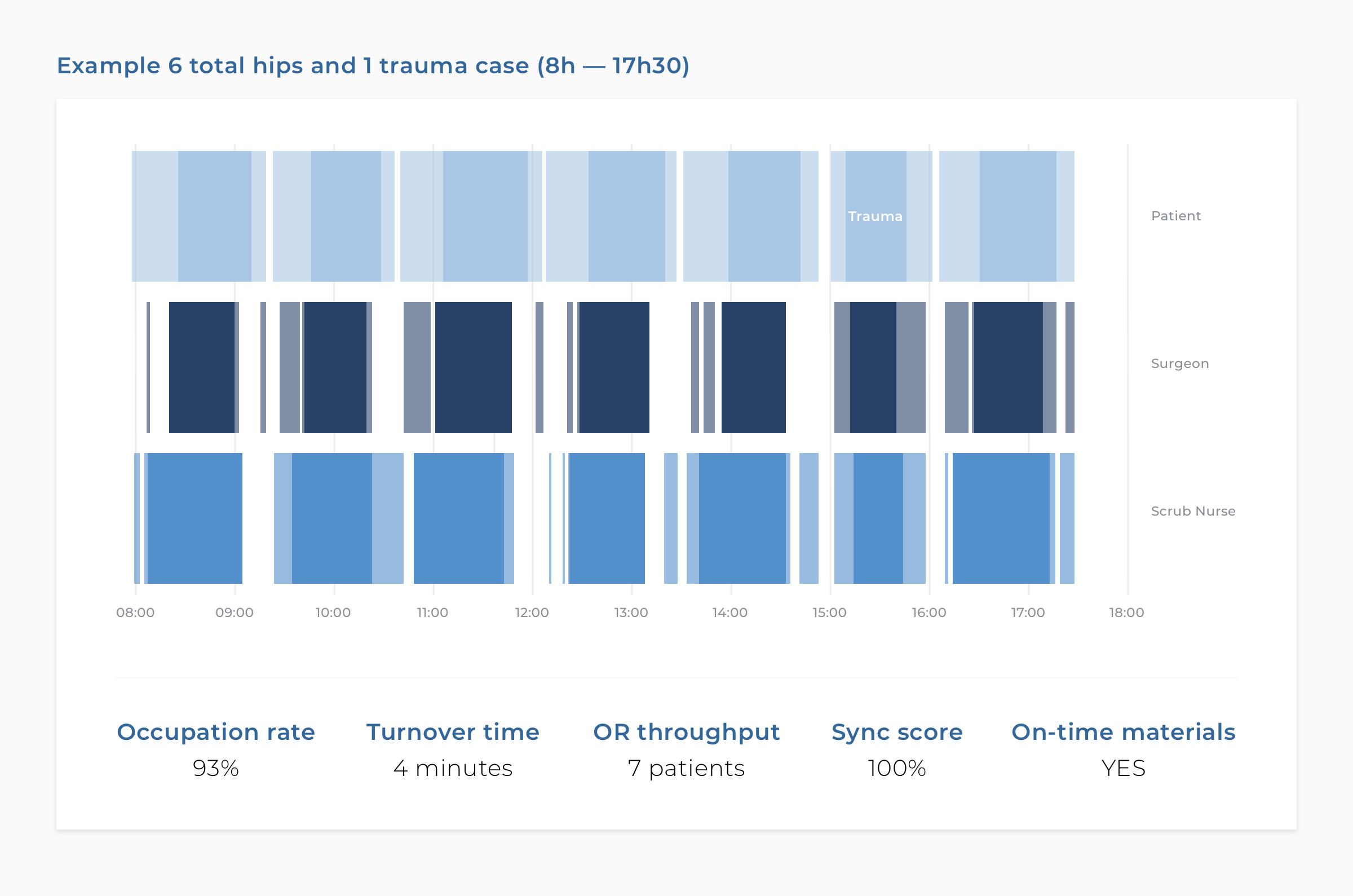
Several improvement opportunities have already been implemented in the OR at GZA, thanks to the data insights. Fine-tuning patient appointments and parallel processing are just two examples.
Improvement example #1: Fine-tuning patient appointment
While data is crucial to obtaining insights into the OR processes, it also gives us an in-depth understanding of the processes surrounding surgery.
At a certain point, one of our medical engineers noticed a critical bottleneck: patients scheduled first in the day arriving too late in the hospital before surgery. Patient delays are detrimental and break off the initial surgical planning, pushing back everything else.
To avoid this situation, we conducted a successful experiment: call in the first two patients at the beginning of the day, making sure there is always a patient ready for surgery.
Improvement example #2: Parallel processing
After measurements in Olyslaegers’ OR, data showed variability in the preparation phase. Low variability is a precursor to consistency and standardization—both critical components for optimal surgical planning, resource allocation, flow of medical staff, and ultimately OR efficiency.
Based on these insights, Olyslaegers introduced parallel processing to decrease the preparation variability, aiming to reduce the overall turnaround time.
He adds, “Previously, I would wait on the sidelines, scrub, and get into the OR when the patient wasn’t ready. Now, I get into the OR immediately, install and start prepping the patient while other team members handle other aspects of the OR setup. Even what appears to be a minor improvement saves us a lot of time.”
“Standardization allows us to have a good time”
The introduction of parallel processing and fine-tuning patient appointments are just some of the efficiency improvements contributing to a smooth flow in Dr. Olyslaegers’ OR; standardization is another.
“If you want to create an enjoyable experience for the surgical team in the operating room, you need to have a standardized procedure where everyone knows what is expected and is prepared for what could go wrong. So, if something deviates from our standard routine, we know how to handle it and quickly get back on track because of our standardized process.”
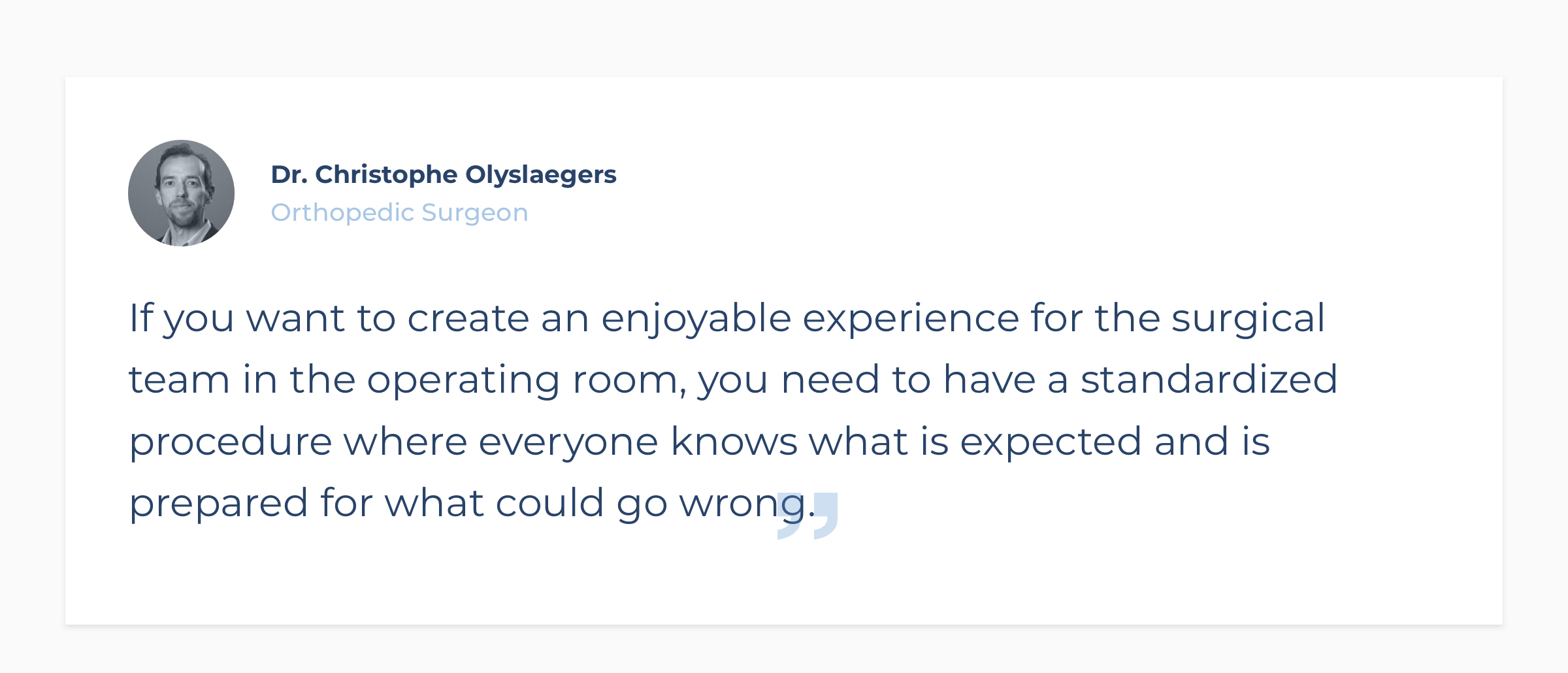
Consequently, Olyslaegers and his team diverge from the perception of standardization as a mechanical way of working, turning humans into machines always doing the same thing.
He explains, “Standardization and simplification allow us to have a good time at work. Every bit of the routine becomes enjoyable, and there is no doubt this creates a much more pleasant environment for everybody.”
In conclusion, he adds, “If you, as a surgeon, are calm, relaxed, and enjoying the process, this will influence the people around you. On the other hand, if you are stressed and nagging all the time, you will radiate that to the nursing team, and they will instantly feel the difference. Work shouldn’t be like that. It should be fun.”
Do you want to know how we can help you get started? Schedule a 15-minute intro call. No strings attached.
PS. If you enjoy this content, you will definitely love the stuff we share on LinkedIn. Make sure you stay in the loop and follow our LinkedIn page.
Add Comment
You must be logged in to post a comment.




